Formula 3 in Morocco in the seventies
An adventure in the Maghreb
Author
- Lorenzo Baer
Date
- March 24, 2024
Related articles
- The 1960-1975 South African Drivers Championships - Grand Prix at the Cape, by Mattijs Diepraam/Felix Muelas/Rob Young
- 1966 Argentinian F3 Temporada - It's never too late to revive old passions, by Lorenzo Baer
- 1968 Argentinian F2 Temporada - The quick dash of the Cavallino Rampante in the Argentinian Pampas, by Lorenzo Baer
- 1969 Tasman Championship - Something that Chris Amon did win, by Tom Prankerd
- 1970-1975 Tasman Championship - Back to Pukehoke for a revival of F5000 Tasman days, by Gareth Evans
- 1971 Colombian F2 Temporada - When Formula cars roared in the Coffee Land, by Lorenzo Baer
- Cuba, Bahamas, Puerto Rico - Racing Juniors in the tropics, by Lorenzo Baer
Who?Charles Geeraerts, Jacques Berenger What?Lotus-Holbay 59, Brabham-Lucas BT28 Where?La Corniche When?1970 GP de la Corniche |
 |
Why?
Africa is one of the most mysterious and intriguing continents on the planet. The cradle of humanity, together with the region's natural beauty, in addition to the diversity of people and cultures, makes the continent peculiar in its existence and importance. African motorsport is also part of this exotic set.
With a tradition linked mainly to cross-country rallies (such as the Safari and Morocco Rallies, and the original Paris-Dakar) single-seater motorsport on closed circuits ends up being just a complement, and not the main element in this equation. South Africa, Rhodesia and Mozambique were perhaps some of the few exceptions to this case, largely due to the former's international GP, in conjunction with the national South African Formula One Championship. Rhodesia, for a period in the 1960s, also had its national GP focused on single-seaters, while the Lourenço Marques GP, in Mozambique, attracted a dozen F1 and Formula Libre competitors every year.
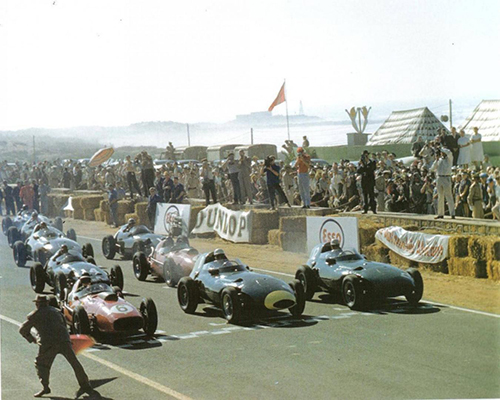
The 1958 Moroccan GP was certainly the highlight of North African motorsport during the 1950s. Drivers such as Moss, Behra, Gendebien and Hawthorn attended the event that officially closed the 1958 International F1 season.
(credits unknown)
Therefore, with the exception of the southern region of the continent, where a good environment for single-seater motorsport developed, much of Africa was dispirited for years, without a national single-seater category. The northern region was especially resentful, mainly due to the incomprehension of not being able to develop any national single-seater category or race, despite its proximity to the largest centre of world motorsport at the time, Europe.
However, at the beginning of the seventies, one country managed to overcome this barrier: Morocco. For some years, between the end of the sixties through the early seventies, the North African nation managed to include Formula 3, the base category of international single-seater motorsport, in its national race calendar. Morocco, one of the few countries on the continent with a tradition in F1, was re-emerging on the international scene in a surprising and unexpected way.
A brief history of single-seater motorsport in North Africa
The first large race focused on single-seaters in the North African region took place in 1925, in Tripolitana, still an Italian colony. The race was sanctioned as a Formula Libre event and was won by Italian Renato Balestro, in an OM 665S. Over the following years, the race grew in significance, becoming by the mid-1930s one of the most important events on the Association Internationale des Automobile Clubs Reconnus (AIACR) calendar.
The race gained even more popularity from 1934 onwards, when the unification of Italian colonies in the region founded what is today's modern Libya, still under Mussolini's rule. The colony's great development process was also somewhat beneficial to the Grand Prix, as the construction of a new track on the dry lake of Mellaha (which had replaced the old Tripoli urban circuit) boosted the popularity of the event to such an extent, that even teams as Mercedes and Auto Union began to regularly attend the site.
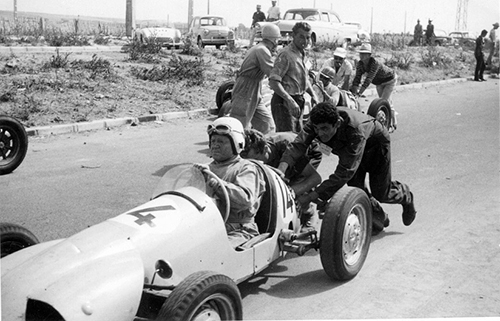
This picture, taken in the early sixties, show how some cars, such as the Panhard Monomill, found a second life in other countries (such as Morocco) after they were deemed outdated by the highest standards of world motorsport.
(credits unknown)
The importance of Mellaha in the development of African motorsport can be stated that at the time of the first races on the track, between 1933/'34, the circuit was one of the most modern race venues in the world. The facilities could comfortably accommodate more than ten thousand spectators, with a level of security comparable to that of the best European circuits.
14 editions of the GP were contested between the years 1925 to 1940, with the first six editions being run on the streets of Tripoli, while the others were held on the Mellaha circuit. Achille Varzi (1933/'34/'36) and Hermann Lang (1937/'38/'39) were the greatest Tripoli Grand Prix champions. The fame of the races in the Italian colonies ended up sparking the interest of other North African territories in hosting their own events: in 1928, both Tunisia and Algeria, both French protectorates, opened their respective GPs.
The Tunis Grand Prix was certainly the most famous of the pair, mainly due to the 1935 and 1936 editions, when the German machines from Auto Union and Mercedes, respectively, dominated the races. But the Tunis GP had a good history even before these races, as in its second edition (1929) foreign drivers already overcame the French dominance, when Italian driver Gastone Brilli-Peri won the race aboard an Alfa Romeo P2.

Before the arrival of the most advanced machines in the period of '69-'70, the Moroccan-made Melis were very competitive machines in the hands of local drivers. Here, a pic taken in a race at La Corniche, in 1969.
(credits Le Tahitien Archive)
In 1931, after a one-year hiatus, the race returned to the international calendar, leaving its original location, the city of Le Bardo, for the Carthage circuit, which incorporated urban roads between the cities of Tunis, Carthage and La Soukra. The track would remain the same until 1937, when the penultimate edition of the Tunis GP was held.
This is because the last official edition of the GP took place almost 20 years later, in 1955, at the (approximate) 3200-metre-long Circuit du Belvedere, which surrounded one of the main parks in the capital of the African colony. However, unlike the first editions, which were contested on Formula Libre, the 1955 edition was open to Touring and Sportscars.
On the other hand, the Grand Prix d'Alger did not enjoy great popularity in the automobile world, being attended mainly by Franco-Algerians. There were five editions contested, four of them on the Staouéli street circuit (1928/'29/'30/'37), with the exception being 1934, when it was held on another street track, Bouzaréah. A curious fact is that only Bugatti cars won the GPs, which was another one open to Formula Libre regulations.
Another event that also took place in Algeria during the 1930s was the Grand Prix d'Oranie. The main intention of the race was to be a rival to the events held in Algiers, demonstrating that a colony could be home to two large-scale motorsport events. Also sanctioned as a Formula Libre event, only two editions of the Oran GP were held: in 1930, with Jean de Maleplane achieving victory, and 1932, this time with Jean-Pierre Wimille taking home the trophy.
However, with the veil of World War descending over the globe at the end of the 1930s, North African single-seater motorsport entered a standby period, from which it never recovered. While many of the cities that had hosted such GPs became battlegrounds, there was nothing that could be done to preserve what North African motorsport had achieved thus far.
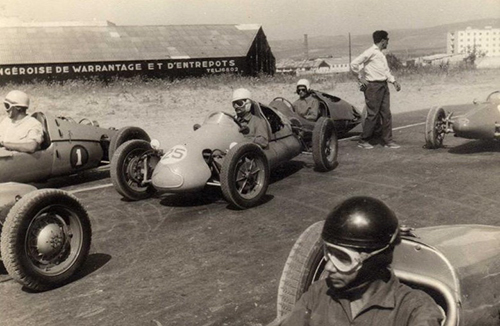
The old F3-FJ Cooper chassis were the preferred ones by the drivers in the 'Formule Nationale' series. Easy to maintain, these cars had their original Norton power plants replaced by others more abundant in Morocco, such as the French Renault, Panhard and Simca engines. The race depicted above happened in 1964, in Tangier.
(credits unknown)
The first minimally organised race in Africa that was open to single-seaters after WW2 took place in 1947, when another country entered the game: Egypt. The event, organised between the Automobile & Touring Club of Egypt and the Circus Racing Organization, a company that would facilitate the arrival of Italian drivers to the race, was a complete fiasco, despite the presence of names such as Ascari, Chiron, Taruffi and Cortese (who was to be the champion of the race). Held on a small 1480-metre circuit in the town of Gezira, only 6000 spectators attended the event.
The race in Egypt served as a signal for the various failures in the following years to revive North African motorsport. However, there are always exceptions to the rule; and the country responsible for it was Morocco, the only country in the region that managed to remain relevant on the international scene in the post-war years.
Even though the first registered race in Morocco happened in 1913, the Moroccan Grand Prix had its origins in 1924. Contemporary to the Tripoli GP, the Moroccan GP was born with the name of Grand Prix International d'Anfa. Despite being held in the suburbs of Casablanca and being a sanctioned event for Formula Libre, the race was never counted in the total tally of Moroccan GPs, perhaps due to the simple fact of the event's nomenclature.

Other foreign machines appeared sporadically to compete in races in Morocco. This image taken at the La Corniche meeting in 1969 shows a Brabham BT21, a car that was very competitive in F3 in 1966 but by 1969 standards, was already entering obsolescence in Europe. (credits Le Tahitien archives)
Only in 1925, with the first Grand Prix of Casablanca, as the race would become known in the coming decades, was the history of the Grand Prix Automobile du Maroc officially opened. Won by Comte de Vaugelas in a Delage, the race was just one of dozens of Formula Libre and Handicap races that dotted the international motorsport calendar in the 1920s.
Between 1925 and 1928 the event was regularly held in Casablanca, curiously returning to Anfa between 1930 and 1932. This time, however, Anfa would host an event classified as a national GP, and in 1934, it was the stage for one of the best editions of the Casablanca Grand Prix, with Monegasque Louis Chiron winning the race.
20 years went by before a race called the Grand Prix Automobile du Maroc took place again, and it was only in 1957 that the race was once again contested by formula cars. In this first edition, held on the new Ain-Diab circuit and classified as a non-championship race, it was a Frenchman who shone: Jean Behra, aboard a Maserati 250F.
In 1958, however, the highlight of Morocco's motorsport history took place: hosting an official stage of the Formula 1 World Championship, the first on the African continent. The race, which was the last round of the 1958 season, was marked by dramatic events, such as the fatal accident of Stuart Lewis-Evans, in addition to the pyrrhic victory of Moss, who despite winning the race lost the world drivers' title to Mike Hawthorn.
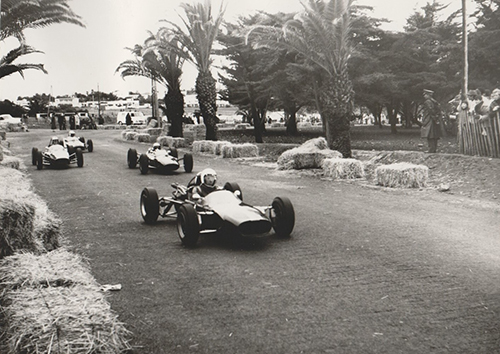
The meeting on La Corniche in 1967, if successful, could have boosted Moroccan single-seater motorsport in a way seen only in the Ain Diab GPs of 1957-'58. In the end, the '67 race was a fiasco, being just another one-off event in the history of international F3. (credits The Mountaineer/Caradisiac)
Even though the race was one of the most successful events on the calendar in terms of competition, the 1958 event was the last official Grand Prix held in Morocco. The high expenses associated with the events, in addition to a series of serious accidents in the '58 race, ruled out any opportunity to hold a single-seater race in Morocco in the short term again.
During the first half of the 1960s, all single-seater races in Morocco took place at national level, going back to its Formula Libre roots. Most of the grids were made up of pre-1960 Formula 3 cars, such as Cooper-Nortons and other nationally built vehicles based on the 500cc engines, as well as some rare Formula Juniors like the DB-Panhards. Several cities hosted such events, such as Taza, the free port of Tangier, as well as the capital Casablanca.
A reasonable-scale event for single-seaters in Morocco only took place again in 1967, when the Fédération Royale Marocaine des Sports Automobiles promoted an international race open for Formula 3 cars. Held on the La Corniche circuit, the event attracted 12 entries: eight drivers from Swiss origin, with only five of them showing up on race day: Bruno Wernli (Saab 850), Hans Uhlmann (Lotus 20 FJ/F.Libre), Arthur Bueb (Brabham BT9 FJ/F.Libre), Paul Fellay (Brabham BT10 F3) and Eduard Wahl (Lotus 27 F3) would compete for the trophy against Moroccans Jacques Berenger (Renault 1000 F. Nationale), Robert Lassus (Cooper-BMC F3) and H. Gelibert (Renault 1000 F. Nationale). However, the best-known name to compete in the race was Frenchman Claude Ballot-Lena (Lotus F3 - this car was very likely the ex-Nick Gold Lotus 41) who would become famous for his constant presence in the Mans 24 Hours.
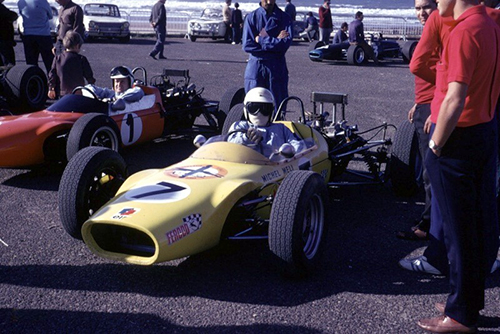
Michel Méli poses for a photo in his Meli, before the race on La Corniche in 1969. (credits Le Tahitien Archive)
In 1968, a similar event was organised in Marrakech, open to Formula 2, Formula 3 and old Formula Juniors cars. Again, some Swiss drivers accepted the invitation, like Arthur Bueb, who made his second appearance in Morocco, and Hans Obrist, who despite being on the original entry list for the 1967 race did not attend the event. This race was won by Frenchman Daniel Gache, with a Ford-powered Brabham F3.
Despite the international presence, these events were not as successful as expected, as there was still a missing link in the chain that would take the Moroccan national single-seater championship to another level: the technological issue. Many of the cars present in these races were old Formula Juniors updated to receive increasingly powerful engines. The problem was that at the end of the sixties these vehicles had reached the end of their useful life, after almost six years of continuous use.
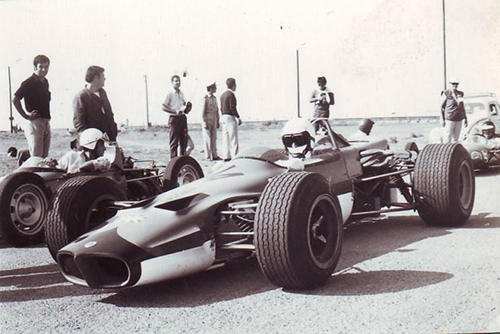
Geeraerts' Lotus 59 was a sign that times in Morocco were changing. The old Formula Juniors would finally give way to true F3 machines, which would reign in the Maghreb lands for the next three years. (credits unknown)
That suddenly changed in 1969 when a Belgian named Charles Geeraerts took a modern Lotus 59 to Morocco, a model that made all the other single-seater competition cars in the country obsolete. The vehicle's impact on national F3 races was immediate, with the driver winning the Agadir, Casablanca and Tangier events. Quickly, the Moroccan drivers looked for ways to answer to the stranger's affront. Thus began the race for the 1970 season of the Moroccan F3 championship.
1970: the first round
Of the ten drivers who competed in at least one round of the Challenge IGOL-F.3 (official name of the Moroccan F3 championship for 1970), five deserve to be highlighted. The first is obviously Charles Geeraerts, who returned for the new season with his Lotus 59, equipped with a Holbay power plant. Holbay Engineering, during the 1960s, was one of the most specialised firms in tuning Ford engines, and even though it was far from the scale and fame of the Cosworth company, Holbay had stood out countless times in the sub-F1 categories, due to its more artisanal work in rebuilding engines.
The biggest threat to Geeraerts would undoubtedly be French-Moroccan Jacques Berenger, who had brought the ex-Tim Schenken Brabham BT28 from Europe. The model which entered production in 1969 was one of the most modern F3 cars available for purchase. Based on the experience of the long-lived Brabham BT23 (built for both F2 and F3) and the more modern BT26 (F1), the car quickly found its place in the market, due to the high demand for low Formula vehicles. Berenger's car was powered by a unit tuned by Lucas, a company almost analogous to Holbay.
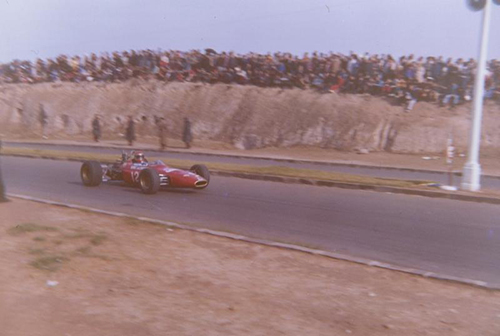
Tony Ré in the De Sanctis-Novamotor at the Grand Prix de la Corniche of 1970. (credits unknown)
Another competitor was Tony Ré, who had also prepared for the 1970 championship by bringing a De Sanctis-Novamotor F3 to Morocco. Despite being considered a second-tier machine by 1970's European standards (see De Sanctis' poor results from 1968 onwards), in Morocco the vehicle was extremely advanced. Ré's car was based on the Italian manufacturer's 1968 chassis, with a parts package that brought the De Sanctis up to the 1969 spec.
Robert Lassus was another who reinvented himself for 1970. The driver sold his old modified formula car made in Morocco to buy an Italian Tecno-Novamotor. This was undoubtedly a great choice by the driver, since, at least in Europe, the Tecnos had been demonstrating excellent performance compared to more technologically advanced cars. Most likely, Lassus's car was one of the dozens TF68s made, with parts and pieces from the 69 and 70 models.
The best hope for Moroccan-built cars was Paul Alfano, who had a indigenous Meli-Renault at his disposal. As few records remain about these cars, Alfano's Meli was most likely equipped with a Cléon-Fonte engine taken from a Renault R8. Because it was modified to participate in single-seater racing, probably these tuned Cléon-Fontes would be able to produce roughly between 90 and 100hp. The striking feature of the Meli was its large air intake at the front of the car, similar to that of the Cooper T81B.
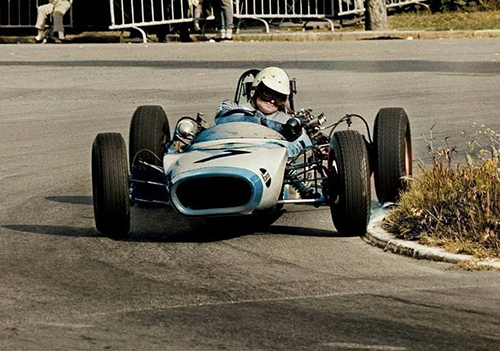
Paul Alfano's second place in the Xème Circuit International de la Corniche was a good testament that the machines produced in Morocco could compete on equal terms in sprint races against their European counterparts. (credits Histoire du Sport Automobile au Maroc)
Seven rounds would count towards the 1970 Moroccan F3 championship, with the first stop being the city of Marrakech. The small circuit, which had been built on the outskirts of the city, was ideal for small cars, which completed laps in just over 1 minute. The weekend of the event was a complete domination by Berenger, who in addition to setting the track record (clocking 1.02.2), secured victory in the season opener. The driver completed the 40 valid laps of the race in 43.20.2, just over 20 seconds ahead of second-placed Geeraerts. Third in the classification was Tony Ré’s De Sanctis.
Almost two months passed before the second race open to F3 cars took place in Morocco. In the meantime, a race had been planned to happen in Rabat, but due to lack of interest in the single-seater race, only the touring and prototype categories raced in the city. Because of that, the second official Formula 3 race took place in the city of Tangier, the intellectual and bohemian center of North Africa. The circuit, 2300 metres long, ran through some of the city's winding streets, turning the circuit into a driver trap. If that wasn't enough, the weather conditions during practice and the race (with some rain and a lot of humidity) served to make the place even more treacherous for the drivers.
During practice, the fastest driver was Robert Lassus, who set a time of 1.16.2. Sharing the front row was Berenger, with a mark 1 second higher. Completing the grid for this race were in order: Paul Alfano (Meli), Charles Geeraerts (Lotus), Tony Ré (De Sanctis), Bernard Dumons (Meli) and Christian Diot (Cooper-Alpine).
The race was split into two heats of 15 laps each; and in the first, Lassus tried to secure first position, with Geeraerts and Berenger hot on his heels. But before lap 3, it was Geeraerts who was leading, after Lassus spun on the still damp Tangier track. This made the battle for the lead extremely heated and during the following laps, Geeraerts and Berenger fought fiercely for this position.
The fight was so intense that on lap 5 the drivers collided, with the Lotus getting the worst of it. Geeraerts' car stopped on the side of the track, while Berenger's Brabham suffered only slight damage and returned to the track, still in second position. This is because Tony Ré, who was in third and watching the duel from a distance, took advantage of the situation to jump into first position.
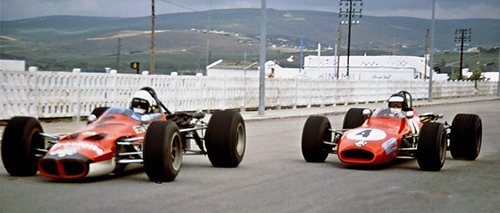
In one image, the two main names of the F3 years in Morocco: Charles Geeraerts (left) and Jacques Berenger (right). Photo taken at La Corniche, 1970. (credits Le Tahitien archives)
A few laps later, however, another change in the lead occurred. While making a turn, Ré was another victim of the puddles on the circuit; the driver lost control and crashed into a wall. As a result of the collision, the De Sanctis' transmission broke, causing the driver to be forced to abandon the race. This meant that Berenger finally took first place, which he would not lose until the end of the first heat, with Lassus and Alfano, in second and third positions, already well behind.
The second race took place in a protocol manner: Berenger circulated calmly around the circuit, without ever being disturbed by any of his rivals. The real battle in this second heat was for the second position, with Lassus, Alfano and Ré (who had managed to make an emergency repair to his car) continuously fighting each other during the 15 laps. Despite all three drivers being less than 1 second behind each other at the final checkpoint, the order did not change, with Lassus and Alfano securing the remaining podium positions.
A week after the race in Tangier, the third leg of the season was assembled, at the Circuit National de La Corniche, in Casablanca. After the loss of the FIA homologation for the Ain-Diab circuit, La Corniche assumed the role of the main venue for car racing in Morocco. Despite this 'new' appearance, La Corniche inherited much of the history of Ain-Diab, such as the incorporation of part of the old circuit into its own route (such as the start-finish straight).
Even before the race took place, several drivers had to remove their entries from the list: Michel Méli and Christian Diot had chronic mechanical problems in free practice, which they were unable to resolve until the qualifying sessions. When the qualifying sessions arrived, however, it seemed that Charles Geeraerts had already overcome his problems from the last race, easily securing first position on the grid. Berenger was in second, with Tony Ré, Alfano and Estegassy completing the top-five of the fastest in qualifying.
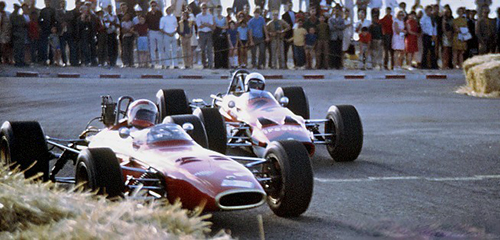
For a few fleeting seconds, Tony Ré managed to stay ahead of Geeraerts in second place in the 1970 GP de la Corniche. The Belgian managed to regain his position soon after, after Ré's accident on lap 6.
(credits Le Tahitien archives)
There would be 15 laps on the 4224-metre-long circuit. And, right at the start, problems, when Geeraerts and Ré jumped it! The grid had to be realigned, and finally at the second flag, the official start of the 2ème Circuit de Vitesse de la Corniche took place. Geeraerts tried to secure the lead, with Tony Ré in second and Jacques Berenger in third.
In less than two laps, Berenger had already moved up to second place, chasing Geeraerts. The repeat of the Tangier duel between the Belgian and the French-Moroccan was smoother than expected, with Berenger making a clean overtake on Geeraerts on lap 4. This duel allowed Ré to approach, who in the following laps began to bother the Belgian in second place.
Further back, Alfano and Estegassy had a hard time. The first started to have engine problems in the first laps, allowing Estegassy to climb to fourth position. However, it didn't take long for the struggling Meli of Alfano to reassume his position, due to Estegassy’s car problems with oil pressure, forcing the driver to withdraw from the race.
At the front, the last serious movement of the race took place on lap 6 when Ré's overtaking move over Geeraerts almost turned into a catastrophe. The De Sanctis driver misjudged his manoeuvre and almost crashed into the side of the track. Luckily, Ré reacted quickly and the only consequences of the accident were lost time and the rupture of an engine gasket. Over the next nine laps, nothing changed in the classification: Jacques Berenger had won another race, this time with an absurd advantage of 1 minute and 15 seconds over second-placed Geeraerts. In third was Tony Ré, even further behind the leading duo.
At the end of June, it was Mohammedia's turn to host a championship race. The 2200-metre route was extremely fast, being a triangular shape street circuit made up of Boulevard des Zenatas, Boulevard Abdel Moumen and the Youssef Ben Tachfine Street. Once again, the duel was polarised by the Berenger x Geeraerts dispute and, yet again, it was the French-Moroccan driver who came out on top at the moment of truth.
The Brabham demonstrated all its virtues at the IXème Circuit de Vitesse de la Ville de Mohammedia, finishing the 30 valid laps of the race almost half a second ahead of Geeraerts' Lotus. In the last position on the podium was Robert Lassus, who, after recovering from an illness that kept him out of the last race in Casablanca, was back to his old form.
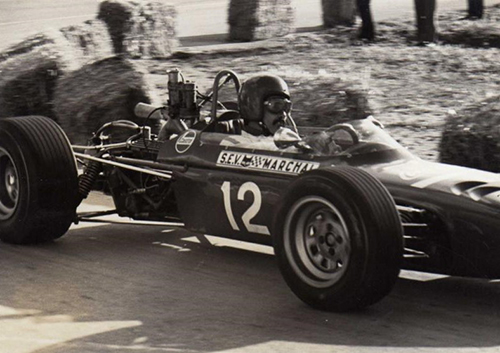
Despite being outdated by European standards, De Sanctis still had its value in African lands. Here, an image of Tony Ré with his Italian machine, during the Tanger race, 1970. (credits unknown)
It was October when the penultimate stage of the season loomed on the horizon. Another new stop, this time the city of Kénitra, located 50 kilometers north of Rabat. The tiny track with a length of only 1200 metres was made up of a set of urban roads close to the current Place de Municipalité. It was the first time that the venue hosted an event at national level, and there was certainly an expectation that the 1er Circuit de Vitesse de Kénitra would not be also the last.
The location might be new, but that didn't seem to bother Jacques Berenger, who continued his impressive streak of victories. The absence of Charles Geeraerts on the entry list could even have meant in the public eye a guaranteed victory for the Brabham driver, but that wasn't exactly how the race developed.
On the small and tight Kénitra circuit, power wasn't everything, and that allowed another player to enter the scene: Robert Lassus. During the fifteen laps of the race, the Tecno was always less than five seconds behind the Brabham, at a breakneck pace through the crowded streets of the Moroccan city. Even so, the surplus that would take Lassus to greater heights was missing, and the driver only managed to be a shade in the wake of Berenger's Brabham.
In the end, it was another victory for Jacques, who now officially clinched the title of Moroccan F3/Challenge IGOL-F.3 Champion. The brave Lassus finished second, less than four seconds behind. Third was Bernard Dumons in a venerable Meli.
Even with the title already decided in Kénitra, the championship only officially ended with the most important event on the Moroccan calendar, which were the series of international races in Casablanca. Held again at the Circuit National de La Corniche, these races attracted moderate attention from outside Morocco, especially for the prototype and GT races.
Despite not attracting any international drivers, the Formula 3 race was one of the main events on the Xme Circuit de La Corniche. Unlike the June race, when the cars competed in a 15-lap race, this time there would only be 10, due to the tighter race schedule for the weekend.
In no way did the title and Berenger's dominant performances in the last races make the driver slow down. The vacuum left by his main rival, Charles Geeraerts, who had once again absented himself from the championship to compete in some races in Europe, had not served to dampen his desire for victory, especially now that the driver saw the possibility of having a perfect season.
And right away in official practice, it seemed like the driver would reach that milestone. Robert Lassus who in Geeraerts' absence had become Berenger's greatest pester, had suffered an accident, seriously damaging his Tecno. The driver and his mechanics would not have the time needed to repair the car before the race – therefore, it was also the end of the championship for Lassus.
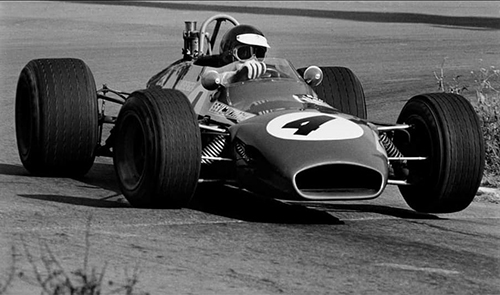
Jacques Berenger swept the 1970 Moroccan F3 season, with his Brabham-Lucas BT28.
(credits Histoire du Sport Automobile au Maroc)
Six F3 cars lined up on the grid for the last race of the season: Berenger's Brabham (BT28), Tony Ré's De Sanctis, the Melis of Alfano, Dumons and Estegassy, and the Cooper-Simca of Fête. At the start, Estegassy had problems with his Renault engine, which died after two hundred metres. Fête also quickly fell behind, as his car was not at the same level of his category rivals.
Berenger had no trouble securing the lead and, at the end of the 10 laps, it was the Anglo-Australian-made car that took victory again, with a total time of 20.56.4. In second place, with a time of 21.19 was Paul Alfano and, completing the podium, Tony Ré.
Thus the 1970 season of the Moroccan F3 Championship/Challenge IGOL-F.3 came to an end. Jacques Berenger finished with 45 points and the isolated leadership of the season, after dominating the championship standings from start to finish. Tied for second place were Geeraerts, Lassus and Alfano, each scoring 18 points. But the 1971 season was already on every driver's radar and, this time, Berenger would not have an easy task as the previous year.
1971: the Challenge stiffens
The 1971 edition of the Moroccan F3 championship was a more professional endeavour for all parties involved. Firstly, the drivers joined dedicated teams that could offer greater infrastructure for the care of the machines. The main squad was undoubtedly the Racer Club, which incorporated into its ranks the best drivers of the 1970 season: Jacques Berenger, Charles Geeraerts, Paul Alfano, as well Michel Méli. Robert Lassus would race for Ecurie Koutoubia, while other teams such as Ecurie Chevreuil, Ecurie Gazelle and the Association des Pilotes de Course de Casablanca (APCC) would also send representatives to the races.
Regarding the machines, no big surprise: Berenger would keep his Brabham BT28, with the only striking difference being the color of the machine – the car's flashy orange gave way to black, with some small details in gold. Charles Geeraerts (Lotus 59) and Robert Lassus (Tecno-Novamotor) had cars virtually identical to those of 1970; while Paul Alfano's Meli had undergone a good revitalisation process, mainly in the car's suspension set.
The good news was from Michel Méli, who had brought a Brabham BT21 to Morocco. As had happened the previous year, with the Tecno and De Sanctis, the BT21, in 1971, was already an out-of-date car for the highest standards of world motorsport. But outside the big circle, the venerable car still had its place. The other noteworthy observation is that the De Sanctis-Novamotor had changed hands: the car that was owned by Tony Ré in 1970 would now be driven by Jean-Gilbert Para.
The race calendar was another item that had undergone revisions: the rounds that would count towards the 1971 Moroccan F3 championship were expanded to eight. Legs in Rabat and El Jadida were added to the schedule, with the expectation that a more extensive championship would attract more entries regularly.

Photo of the starting grid in Marrakech. Sharing the front row are Charles Geeraerts (right) and Jean-Gilbert Para (left). Behind Geeraerts' Lotus, Berenger's black Brabham can be seen. (credits Le Tahitien archives)
As in 1970, the championship would kick off in Marrakech, at the XIIIème Circuit de Vitesse de Marrakech. In qualifying, the fastest was Belgian Geeraerts, giving a direct message to current champion Berenger, who took third place. In addition to them, Robert Lassus, Gilbert Fête, André Roman, Daquin, Jean Gilbert-Para and Michel Méli completed the grid for the opening race of the championship.
The race was divided into two heats of 15 laps each: at the start of the first, Geeraerts tried to secure the lead in the first corner, with Berenger on his heels. The French-Moroccan methodically waited for an opening from his opponent, which happened on the second lap. Lassus, who had lined up in second position, had a terrible start, due to clutch problems that prevented the driver from engaging the correct gear at the green flag. At the end of the first lap, the driver was last, but was consistently closing in on his rivals.
Paul Alfano also took advantage of Lassus' problems, definitively taking third position. Once back in the lead, Geeraerts and Berenger fought wheel-to-wheel in the corners, with the Lotus appearing to be clearly faster than the Brabham. And this was confirmed on lap 7, when Geeraerts managed to execute a beautiful move over Berenger, retaking the lead. And this time, Berenger's response didn't come, with the driver contenting himself with second place. At the end of the 15 laps, the driver was already 14 seconds behind the winner Geeraerts, who was already preparing himself mentally for the final race of the day.
And this was without a doubt the highlight, in terms of emotion. Starting in first position again, Geeraerts looked like he would finally break Berenger's unbeaten run. But at the end of the first lap, the driver made a mistake and spun close to the main grandstands of the Marrakech circuit. Geeraerts luckily avoided colliding with any object, the greater loss being lost positions and time.
At the beginning of the third lap, Berenger was 20 seconds ahead of Geeraerts, and, although the Belgian began to perform superbly in the following laps, managing to lap two seconds faster than the French-Moroccan, it seemed that the fight for the lead was a lost cause. But on lap 6, a turnaround, when the car no. 14 of Geeraerts appeared in the lead! This was because a leak in the Brabham's oil system had forced Berenger to abandon the race.
Thus, the Belgian tried to smoothly drive his car to the finish line. After a year of domination, in the first race of 1971, a new driver climbed onto the highest step on the podium; and his name was Charles Geeraerts. His companions on the lap of honour were Gilbert Fête and André Roman, who after adding up their times, had placed second and third overall, respectively.
The second stop of the Moroccan F3 championship would be the country's capital, Rabat. The Circuit de Vitesse de la Ville de Rabat, just 1100 metres long, was very popular with the country's touring car drivers, but not so much with the single-seater ones. This was reflected in the disappointment of the organisers, who on the eve of the event had only four cars entered for the Formula 3 race.
Charles Geeraerts and Jacques Berenger again dominated the qualifying races, with the Brabham being the fastest. Much slower were Roman (Nava-Renault) and Daquin (Meli-Renault), who seemed to be in a separate race. On the day of the race, due to the low number of competitors, it was decided that only 20 laps would be contested, divided into two heats of 10 laps each.
The duel in the first heat lasted a few laps, with Berenger firmly established in first position and Geeraerts in second. Before the second half of the heat, however, the Belgian made a series of mistakes in the track's tightest corners, losing contact with his rival. The French-Moroccan capitalised on his opponent's errors and at the end of the heat, was already 15 seconds ahead of his European rival.
The second race, however, was more interesting to the crowd, as it seemed that Charles Geeraerts had recovered from his failures and was now applying firm pressure on Berenger. During the ten laps, the Belgian and his Lotus trailed the Brabham, with the margin between the two remaining mostly around one second. But Jacques Berenger did not give in to the pressure, and at the chequered flag it was once again he who crossed in the lead.
Even with this result, Geeraerts continued to lead the 1971 Challenge F.3, with 15 points. Berenger was in second, with 11. Next in the ranking was Roman, who after the two third places achieved in the two rounds so far (Marrakech and Rabat) had 8 points.
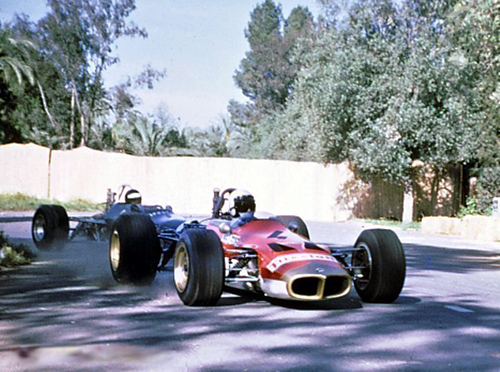
Charles Geeraerts and Jacques Berenger in their small private skirmish, during the 1971 Moroccan F3 season premiere in Marrakech. (credits Le Tahitien archives)
Going from one major city to another, the championship's next stop was Casablanca and its well-known La Corniche circuit. By the country's standards, this would be a great race for Formula 3, as nine cars had been registered on the entry list of the category. But that number shrunk to eight before official practice even began, due to chronic mechanical problems in thes Beck-Holbay of Estegassy.
Therefore, on the day of the race, eight machines from the most diverse origins lined up for the 'Petit' Circuit de Vitesse de La Corniche, which would last 20 laps. The one who shot ahead was Geeraerts, with Jean-Gilbert Para following close behind. Jacques Berenger had a terrible start, losing positions to Méli and Lassus before the first corner.
But Berenger would not be overtaken that easily and, before the end of the first lap, the driver was already back in third place. Geeraerts opened up some advantage, however small, in the lead, as Berenger was now starting to threaten Para. It didn't take long for the Brabham to overtake the De Sanctis, with Berenger on the fourth lap already targeting leader Geeraerts. However, the pace of the race stabilised in the following laps, with the leader maintaining a consistent gap to his pursuer.
On lap 8, Jean-Gilbert Para, who was in a comfortable third place, was forced to retire from the race due to engine problems. This saw Lassus move up into the podium positions, with Méli eager to steal that position from the driver. On the next lap, another change in the lead as Berenger managed to overtake Geeraerts. The Belgian's car seemed to be much slower on the track than in previous laps, and it didn't take long for Lassus, Méli and Alfano to also take advantage of the driver's misfortunes.
The situation got worse in the final laps of the race when Geeraerts missed the braking point at the Sables d’Or curve (where the current Anfaplace shopping mall is located) and ended up spinning there. Berenger, who was arriving to put a lap on the Lotus almost collided with Geeraerts, as he returned from the side of the track. Luckily, the situation was nothing more than a scare, and both continued to the chequered flag.
Jacques Berenger had resumed his form, securing two successive victories in the championship. In second place was Robert Lassus, who scored his first points in the general classification of 1971. Completing the podium was Michel Méli, in his trusty Brabham BT21.
A few weeks later, the traditional event in Mohammedia began its tenth edition and with it, the fourth round of the 1971 Challenge F3. Once again featuring a reasonable number of entrants (ten in total), the race promised to be one more chapter in the duel between Berenger and Geeraerts. And this battle started in practice when both drivers managed to set almost identical times in the sessions but by a few measly hundredths, it was the Belgian who secured the right to start in the pole.
Once again, the race was split into a heat system, with their combined times used to form the final classification. By the time the cars were pushed into their starting positions, only seven showed up for the final moments as Daquin, Jean-Gilbert Para and Gobin had each had their sort of problems in practice and were unable to participate in the decisive moment.
Given permission to start in the first heat, Geeraerts held the lead, with Méli and Lassus in hot pursuit. As on La Corniche, Berenger had problems at the start, with the engine hesitating at the starting signal. At the end of the first lap, Jacques was in fourth place, with Alfano, Roman and Fête following close behind.
In the following laps, Berenger counted on the retirements of Méli, and then Lassus, to return in second position. On the tenth lap, the driver was already focusing on an approach plan towards Geeraerts who seemed calm in the lead. Little by little the Brabham BT28 began to close the gap, with Berenger setting the absolute lap record on the Mohammedia track in one of these laps, with a 1.06.2. But nothing the French-Algerian tried would be enough to remove the Belgian from the lead, as he held firm in this position until the end of the heat. At the chequered flag, the final order was: 1st Geeraerts; 2nd Berenger; 3rd Roman.
For the second heat, the starting grid was remodeled again. Some cars that had retired from the first round returned, thus increasing the numbers. Again, at the start, Geeraerts shot ahead followed by Lassus and Berenger. However, Lassus' Tecno, which had intervened in the middle of the duel between the two stars of the championship, did not last long in this position due to a problem with its Novamotor engine.
The rest of the heat was marked by an error-free performance from Geeraerts, who left no clear opportunity for Berenger to take the lead. The Belgian tried to always have a comfortable advantage over his main rival, demonstrating that Lotus was performing better than Brabham at the Xème Circuit de Vitesse de la Ville de Mohammedia. And in the end, the result of the first heat was repeated in the second: Geeraerts crossed the finish line first, followed by Berenger and Roman.
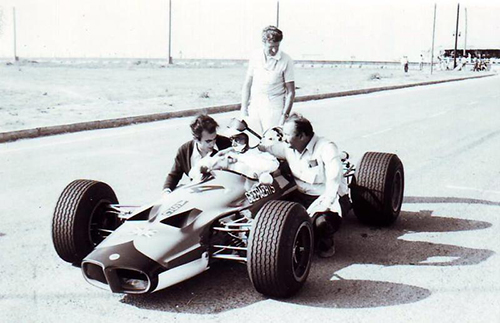
Charles Geeraerts and his small team at the El Jadida circuit. Photo taken around 1970-'71. (credits unknown)
The next destination was the El Jadida circuit, located almost 100 kilometres south of Casablanca. The event marked the start of the second half of the 1971 Challenge F.3 season which so far had Jacques Berenger in the lead with 26 points. Charles Geeraerts, who after the victory in Mohammedia had closed the gap to two points, was in second with 24. André Roman was third in the standings with 14 points, while Lassus, Meli and other drivers had less than 10 points each.
El Jadida hosted an automobile event for the first time in 1971, on a 1993-metre-long circuit. The problem was that the same situation that hampered the Rabat race happened once again: despite being a success with all the other categories that showed up to compete in races at the location, as could be seen in the touring car and Formula Ford races, the same could be said for the Formula 3 race.
Only three drivers in the category would deign to attend the race: Fête, Geeraerts and Roman. Due to the small number, it was decided even before the start of the category race that championship points would not be awarded, with the race in El Jadida considered, at least for F3 cars, as a non-championship race. Even so, those present did not refuse to compete in a small race for the public present – and, as expected, it was Geeraerts who took home the trophy, followed by Roman and Fête.
But El Jadida's disappointment would be in the past when the next race weekend in Tangier arrived. This time, Formula 3 would not be the main star of the day, being relegated to the role of support event for what would be the 2 Heures Internationales de Tanger de 1971, a race aimed especially at touring cars. Perhaps, and because of this, once again, the number of entries was lower than expected, with only four drivers appearing in the coastal city.
In the absence of Geeraerts, this time it was Berenger who shone against the sparse competition. In free practice, the driver was 1 second faster than his closest pursuer, Michel Méli. But during the race itself, things weren't as easy as they seemed. Throughout the 15 laps of the GP, Berenger had to fend off a series of attacks from Paul Alfano, who was making a surprising appearance with the indigenous Meli. In the final laps, however, Berenger managed to increase his advantage, finishing the race four seconds ahead of his pursuer. Méli finished third, 1 lap behind Berenger and Alfano.
Due to the problems in obtaining a minimum number of entrants in the two previous F3 races, the organisers of the penultimate stage of the year, which would take place at La Corniche, took the serious decision to cut the category's race from the race schedule. This did not go down well with the drivers, as the end-of-year international meeting at La Corniche was the best stage for Moroccan pilots to stand out, due to the foreign attention that the race attracted. But the hammer was already down, and a good opportunity was lost to once again demonstrate the country's potential in the single-seater categories.
It was now up to the Formula 3 drivers to wait for the last round of the year, which would take place on the tight Kénitra Circuit. The race would be decisive: both Berenger and Geeraerts had a real chance of winning the title, with whoever came in front being crowned the Champion du Maroc des Pilotes de Course. Seeking every way to gain a small advantage over his rival, Berenger even brought to Kénitra a new aerodynamic package, installing wings on the front of his Brabham. On the other hand, Geeraerts trusted in the rough power of his Lotus.
In the practice sessions, however, it seemed that Jacques Berenger's modifications were the most successful, with the driver securing the fastest times and pole position for Sunday's race. Charles Geeraerts came soon after, making it clear that he had no prospect of letting his rival achieve his second title.
Seven cars lined up for the race, which would only have 12 laps. The race would be a quick shoot, as on a circuit that was just over 1 kilometre long, the laps were below the 1-minute mark. When the flag was dropped, Berenger reacted fastest, jumping into the lead of the race. Geeraerts filled the Brabham vacuum, followed by Alfano and Méli. The other drivers in the race, Daquin, Lyazidi and Roman, soon dropped back as the race progressed.
By the middle of the race, Méli had risen to third due to Paul Alfano's retirement. But the most dramatic moment of the race came on lap 10 when in an effort to take first position, Charles Geeraerts overdid it in one of the corners, missing his braking point and heading for a collision course with the side of the track. The driver tried to save his car, but it failed to react.
The impact with the curb was so strong that two of the car's wheels came off, putting an end to the Belgian's aspirations in the 1971 F3 championship. This left a clear path for Berenger who over the next two laps tried to guide his car smoothly through the streets of Kénitra. In the end, the driver finished the race in 11.12.6, almost a minute ahead of second-placed Michel Méli and, closing out the final podium of the season, was Daquin.
Jacques Berenger thus won his second title of Champion du Maroc des Pilotes de Course in two almost perfect seasons. Of the 13 races contested over two years, Beranger had won 10 – a success rate of over 75%. Therefore, the Brabham had proven its worth in the desert as a victorious vehicle in one of the most peculiar conditions found in world motorsport.
1972: new players and twilight
Although 1971 ended on a high tide in Moroccan Formula 3, some serious questions hung over the organisers' minds as they looked back on the championship. Of the eight races planned for the year, three did not reach the minimum number of competitors to be classified as point-scoring events, which represented a waste of 37.5% of the total number of races. Many factors can be considered the cause of this problem.
The first could arguably be the polarisation of the championships in the hands of Geeraerts and Berenger, as the pair had vastly superior cars to their rivals. Another likely cause was the cost of maintaining vehicles as unique as the F3 in racing conditions, in a place with very precarious infrastructure, such as Morocco. With the exception of the Melis and other locally built machines (which had a good stock of parts for immediate replacement) drivers with foreign machines were in 'dire straits' – any problems they had, they would need to relinquish in foreign support, and until the help arrived, precious time would have already passed.
Because of this, the organisers of the Challenge F3 had difficulties in preparing a calendar of events for 1972. Without knowing for sure which and how many drivers would be able to compete regularly in the championship, the season started with uncertainty, so that rounds could be inserted and withdrawn as the year progressed. As a desperate measure to increase competitiveness for 1972, the organisers even relaxed the rules by allowing vehicles up to 1300cc on the grid.
But in the end, only two serious F3 races were held in the African country in 1972: at the restructured Meknès circuit and at the traditional Mohammedia track. El Jadida was also on the list of F3 venues for 1972, but the lack of quorum meant that only GTs competed in the race there.
Meknès, located almost halfway between Rabat and Fez, would be the opening stage of the season, returning after a long hiatus to host a stage of the Moroccan drivers' championship. The new version of the circuit, revealed to the public just a few weeks before the race, was 2370-metres long, running along Avenue des Forces Armées Royales, then the Avenue Idriss II and with the last sector in the Avenue Moulay Ismail, close to Place Administrative. The track was very fast, especially considering that it was a street track.
When the final list of entries was officially published, the biggest absence felt was that of Belgian Charles Geeraerts. After two and a half years spent racing Formula 3 in Morocco, and GTs and saloon cars in Europe, the driver finally decided to focus solely on touring cars, leaving his career in single-seaters behind. Because of this, the driver put his Lotus 59 up for sale, which was promptly purchased by Moroccan driver Jeff Catala. Another traditional figure on the grid who would not be present was Robert Lassus, largely due to the difficulty and cost of maintaining the Novamotor engine of his Tecno in Morocco.
Even so, seven cars attended the IVème Circuit de Vitesse de Meknès. And without any surprises, it was Berenger who proved to be the fastest in practice, securing the pole position on the starting grid. Méli and Alfano came closest to Berenger while Catala, who clocked the fourth best time, was still getting used to his new machine.
For race day, 30 laps would be contested, divided into two heats of 15 laps each. And the first was undoubtedly a crowd-pleasing spectacle. Berenger jumped ahead, followed by Alfano (Meli-Renault), Méli (Brabham-Holbay), Genna (Cooper-Renault) and Catala (Lotus-Holbay). Dechonne (Castagny-Renault) and Lyazidi (Navas-Renault) were already further behind the pack.
In the following laps, the top five remained in a compact group, with no driver managing to open up more than a second to his rival. Méli later managed to overtake Alfano, while Catala moved up to fourth, after Charles Genna had to abandon the race on lap 7, due to clutch problems. Even so, such movements were not synonymous of a platoon breaking apart, but rather with a block that was increasingly solid. It was only in the final laps of the heat that Jacques Berenger managed to gain some advantage over his rivals, having crossed the finish line a few seconds ahead of second-placed Méli.
On the other hand, the second heat was much more predictable than the first: once again Berenger was in the lead at the end of the first lap, but this time, followed almost instantly by Méli. In third position, an interesting battle between newcomer Catala and veteran Alfano was unfolding, with each trying to make the most of the strengths of their cars.
In the end, it was the audacity and greater power of Catala's Lotus that prevailed, with the driver seeking to open up some advantage over his rival, with a view to securing third place in the combined heat times. Lap after lap the cars began to spread out across the track, with the two Brabhams safely in the first two positions. And, in the final moments of the race, Berenger still had time to set a new track record, clocking a 1.16.1.
Victory once again came naturally to Jacques Berenger, who collected yet another trophy for his already reasonable collection of achievements in Morocco. Michel Méli was satisfied with second position, while Jeff Catala, on his debut, managed to overcome Alfano, taking third place on the podium. Despite this promising race, a long time would pass before enough candidates were brought together again to compete in an F3 race in Morocco. And this would be a glorious end to the category's spectacle in the country.
A few months had passed since the Meknès race, and new changes to the grid had taken place. Jean-Gilbert Para had sold his De Sanctis-Novamotor to another Moroccan driver, Michel Spagnolo. In Mohammedia, the atmosphere was expectant, as nine pilots signed up for the race.
Spagnolo was already a driver with some experience in local motorsport, especially in touring events in which the Moroccan drove a Gordini. Another peculiar attraction for Mohammedia was the Englishman 'Campbell', who arrived in Morocco with a Lotus Formula Ford. Exploring this combination, much probably the Moroccan press was referring to Mike Campbell-Cole, a driver who had enjoyed a good stint in the BTCC between 1964/'65 and who was a regular Formula Ford driver in the early seventies – regarding the car, it can be assumed that it was a Lotus 69 FF, as the model can be recognised in some later photos of the race; it was also referred by the local press as an 'inferior car' and a 'fake Lotus', as it was not a genuine Formula 3.
But it was only on the track that definitive conclusions could be drawn, and the day before the official race, the seven drivers present left what they could during the timed sessions on the Mohammedia circuit. Berenger, Catala and Méli exchanged fastest laps, while the other drivers were unable to perform as well. In the end, Berenger once again came away with the upper hand, after managing to set a spectacular lap of 1.08. Jeff Catala wasn't far behind, with his best lap a 1.09.1. The rest of the grid was formed as follows: third Méli; fourth Spagnolo; fifth Campbell; sixth Daquin; and seventh Deligarde (these last two not setting times).
The following day, everyone was ready to compete in the two heats valid for the XIème Circuit de Vitesse de Mohammedia. The flag was dropped for the first time and the drivers set off at full speed along Boulevard Abdel Moumen, Berenger in the lead, with Catala in hot pursuit. The duel between the two was the highlight of the day, even if it was ephemeral. In just a few laps, Catala managed to overcome the almost unbeatable Berenger, relegating the Brabham to second place.
And this really didn't seem like a very auspicious day for the Anglo-Australian brand's cars. Before the end of the first heat, Michel Méli had to withdraw from the race, due to problems with his BT21. This made the third position fall into Spagnolo's lap, who would hold it firmly until the end of the heat. Without any other movement, this is how the first part of the race ended, with Catala crossing the finish line less than 1 second ahead of Berenger. Spagnolo, in third, was already well behind the leaders, with a disadvantage of almost forty seconds at the chequered flag.
A few minutes later, everyone was ready for the final heat of the day – and this was almost a repeat of what had happened earlier. Berenger jumped ahead, but this time, Catala was quicker to respond, taking the lead on the same lap. Spagnolo and Campbell had a brief skirmish, before the Englishman began to lose contact with the Moroccan.
And so, the 15 laps of the heat went by, with each driver following their own pace. When Catala crossed the finishing straight for the last time, he had completed the race in 17.2, 5 seconds ahead of Berenger, with 17.7. Once again in third position was Spagnolo, already one lap ahead of Campbell and Daquin, the only two other cars to complete the race. Jeff Catala's victory was surprising and unexpected, as in only his second race, the freshman had surpassed two-time Moroccan champion Jacques Berenger, in a robust and error-free performance.
However, when everything seemed to indicate that from now on, a new attraction would brighten the Formula 3 races in Morocco, the category entered a dead spot in the country. Although new names like Catala and Spagnolo were an attraction in themselves, this was by no means a solution to the category's main problem, which was attracting more drivers. Catala, Spagnolo, Dechonne and Lyazidi did not enter by expanding the grid, but rather, taking places from other drivers who had left the category. Therefore, despite at least two to three new faces appearing each year on the F3 grids, the number of cars present was always close to six or seven.
Besides that, a serious internal crisis in Moroccan motorsport has put any future development at check. In the middle of 1972, APCC, one of the main teams responsible for organising automobile events in the country, began to fall apart, leaving a large vacuum in the management of the calendar from that date on. This demonstrated the fragility of the country's motorsport as a whole, which with the absence of one of its biggest players, had no one to rely on to overcome this problem.
Also, the costs of maintaining an operation in F3 were taking its toll now, something that was fatal to the long-term objectives of expanding the category to other North African nations. Therefore, after the Mohammedia race weekend, little was done to reorganise single-seater races in the country (with the exception of some occasional F4/Formula Nationale events). Attention now turned to touring and saloon cars, much cheaper and more abundant than the singular F3 machines.
Why to read me?
With the exception of the surprisingly successful South African experience in its own national Formula 1 championship, which existed between 1960 and 1975, it was in Morocco that a high-performance Formula category survived for the longest time on the African continent. The arrival of cars such as the Brabham BT28 and the Lotus 59, between 1969 and 1970, gave a new boost to the category in the Maghreb region, attracting attention from a crowd that was not used to seeing such peculiar machines.
Even so, the insistence and resilience of local clubs (through the various Ecuries) in continuing to keep such events open to F3 on the calendar is worthy of admiration from anyone passionate about motorsport. In conditions as precarious as those in Morocco, where even F3s (the simplest and most robust formula cars available) struggled to stay healthy in a season with few races, it is a feat that at least six cars consistently appeared to contest the races. A number that would seem humble anywhere in the world, but in Africa had almost the same meaning as a full grid at the Nürburgring or Monza.
Over three years and 17 rounds, Formula 3 in Morocco experienced ups and downs, with great disputes interspersed with extremely monotonous races. But in the end, which category of world motorsport lives only through anthological moments? The answer can be only one: none!
Final results F3 races in Morocco
1970 | ||||
RACE 1 – XIIème Circuit de Vitesse de Marrakech | ||||
| 1. | Jacques Berenger | Brabham-Lucas | 40 laps | 43m20s |
| 2. | Charles Geeraerts | Lotus-Holbay | 40 laps | 43m43s |
| 3. | Tony Ré | De Sanctis-Novamotor | 40 laps | 44m16s |
| 4. | Paul Alfano | Meli-Renault | 37 laps | |
| 5. | Robert Lassus | Tecno-Novamotor | 26 laps | |
| 6. | Michel Méli | Brabham-Cosworth | 10 laps | |
RACE 2 – Vème Circuit de Vitesse de Tanger | ||||
| 1. | Jacques Berenger | Brabham-Lucas | 30 laps | 33m38s |
| 2. | Robert Lassus | Tecno-Novamotor | 30 laps | 33m59s |
| 3. | Paul Alfano | Meli-Renault | 29 laps | |
| 4. | Bernard Dumons | Meli-Renault | 21 laps | gearbox |
| 5. | Tony Ré | De Sanctis-Novamotor | 18 laps | transmission |
| 6. | Christian Diot | Cooper-Alpine | 17 laps | engine |
| 7. | Charles Geeraerts | Lotus-Holbay | 5 laps | accident |
RACE 3 – Circuit National de la Corniche | ||||
| 1. | Jacques Berenger | Brabham-Lucas | 15 laps | 19m32s6/10 |
| 2. | Charles Geeraerts | Lotus-Holbay | 15 laps | 19m39s4/10 |
| 3. | Tony Ré | De Sanctis-Novamotor | 15 laps | 20mm36s4/10 |
| 4. | Paul Alfano | Meli-Renault | 14 laps | |
| 5. | Michel Estegassy | Beck-Holbay | 7 laps | engine |
| 6. | Robert Lassus | Tecno-Novamotor | 0 laps | accident during practice |
| 7. | Michel Méli | Brabham-Cosworth | 0 laps | accident during practice |
| 8. | Christian Diot | Cooper-Alpine | 0 laps | car not ready |
| 9. | Bernard Dumons | Meli-Renault | 0 laps | did not arrive |
RACE 4 – IXème Circuit de Vitesse de la Ville de Mohammedia | ||||
| 1. | Jacques Berenger | Brabham-Lucas | 30 laps | 34m29s6/10 |
| 2. | Charles Geeraerts | Lotus-Holbay | 30 laps | 34m56s8/10 |
| 3. | Robert Lassus | Tecno-Novamotor | 20 laps | |
| 4. | Bernard Dumons | Meli-Renault | 14 laps | |
| 5. | Paul Alfano | Meli-Renault | 13 laps | |
RACE 5 – 1er Circuit de Vitesse de Kénitra | ||||
| 1. | Jacques Berenger | Brabham-Lucas | 15 laps | 13m34s4/10 |
| 2. | Robert Lassus | Tecno-Novamotor | 15 laps | 13m38s2/10 |
| 3. | Bernard Dumons | Meli-Renault | 14 laps | |
| 4. | Tony Ré | De Sanctis-Novamotor | 7 laps | |
| 5. | Paul Alfano | Meli-Renault | 4 laps | engine |
RACE 6 – Xème Circuit International de la Corniche | ||||
| 1. | Jacques Berenger | Brabham-Lucas | 10 laps | 20m56s2/10 |
| 2. | Paul Alfano | Meli-Renault | 10 laps | 21m19s2/10 |
| 3. | Tony Ré | De Sanctis-Novamotor | 10 laps | 21m38s |
| 4. | Bernard Dumons | Meli-Renault | 10 laps | 22m13s3/10 |
| 5. | Gilbert Fête | Cooper-Simca | 5 laps | |
| 6. | Michel Estegassy | Beck-Holbay | 1 lap | engine |
1971 | ||||
RACE 1 – XIIIème Circuit de Vitesse de Marrakech | ||||
| 1. | Charles Geeraerts | Lotus-Holbay | 30 laps | |
| 2. | Gilbert Fetê | Cooper-Simca | 30 laps | |
| 3. | André Roman | Nava-Renault | 28 (?) laps | |
| 4. | Michel Méli | Brabham-Cosworth | 27 (?) laps | |
| 5. | Jacques Berenger | Brabham-Lucas | 21 laps | leak in the oil system |
| 6. | Paul Alfano | Meli-Renault | 14 laps | engine problems (1st heat) |
| 7. | Jean-Gilbert Para | De Sanctis-Novamotor | 15 laps | damaged clutch |
| 8. | Robert Lassus | Tecno-Novamotor | 15 laps | engine problems |
| 9. | Daquin | Meli-Renault | 0 laps | fuel pump |
RACE 2 – Grand Prix de Vitesse de la Ville de Rabat | ||||
| 1. | Jacques Berenger | Brabham-Lucas | 10 laps | 9m21s1/10 |
| 2. | Charles Geeraerts | Lotus-Holbay | 10 laps | 9m31s6/10 |
| 3. | André Roman | Nava-Renault | 9 laps | |
| 4. | Daquin | Meli-Renault | 9 laps | |
RACE 3 – “Petit” Circuit de Vitesse de la Corniche | ||||
| 1. | Jacques Berenger | Brabham-Lucas | 20 laps | 25m50s3/10 |
| 2. | Robert Lassus | Tecno-Novamotor | 20 laps | 26m20s3/10 |
| 3. | Michel Méli | Brabham-Cosworth | 20 laps | 26s32s1/10 |
| 4. | Paul Alfano | Meli-Renault | 19 laps | |
| 5. | André Roman | Nava-Renault | 17 laps | |
| 6. | Daquin | Meli-Renault | 15 laps | |
| 7. | Jean-Gilbert Para | De Sanctis-Novamotor | 8 laps | engine |
| 8. | Charles Geeraerts | Lotus-Holbay | 15 laps | disqualified |
| 9. | Michel Estegassy | Beck-Holbay | 0 laps | did not arrive |
RACE 4 – Xème Circuit de Vitesse de la Ville de Mohammedia | ||||
| 1. | Charles Geeraerts | Lotus-Holbay | 20 laps | |
| 2. | Jacques Berenger | Brabham-Lucas | 20 laps | |
| 3. | André Roman | Nava-Renault | (?) laps | |
| 4. | Paul Alfano | Meli-Renault | (?) laps | |
| 5. | Robert Lassus | Tecno-Novamotor | (?) laps | engine problems |
| 6. | Michel Méli | Brabham-Cosworth | (?) laps | |
| 7. | Gilbert Fête | Cooper-Simca | (?) laps | |
| 8. | Daquin | Meli-Renault | 0 laps | car not ready |
| 9. | Jean-Gilbert Para | De Sanctis-Novamotor | 0 laps | car not ready |
| 10. | Gobin | Beck-Holbay | 0 laps | car not ready |
RACE 5 – Circuit de Vitesse d’El Jadida | ||||
| 1. | Charles Geeraerts | Lotus-Holbay | 15 laps | 16m57s2/10 |
| 2. | André Roman | Nava-Renault | 15 laps | 17m16s2/10 |
| 3. | Gilbert Fête | Cooper-Simca | (?) laps | |
RACE 6 – Deux Heures de Tanger (support event) | ||||
| 1. | Jacques Berenger | Brabham-Lucas | 15 laps | 27m34s2/10 |
| 2. | Paul Alfano | Meli-Renault | 15 laps | 27m38s1/10 |
| 3. | Michel Méli | Brabham-Cosworth | 14 laps | |
| 4. | Daquin | Meli-Renault | 0 laps | car not ready |
RACE 7 – 2ème Circuit de Vitesse de Kénitra | ||||
| 1. | Jacques Berenger | Brabham-Lucas | 12 laps | 11m12s/10s |
| 2. | Michel Méli | Brabham-Cosworth | 12 laps | 12m05s1/10 |
| 3. | Daquin | Meli-Renault | 11 laps | |
| 4. | Charles Geeraerts | Lotus-Holbay | 10 laps | accident |
| 5. | Youssef Lyazidi | Nava-Renault | (?) laps | |
| 6. | Carassus | Beck-Holbay | (?) laps | |
| 7. | Paul Alfano | Meli-Renault | (?) laps | |
| 8. | André Roman | Nava-Renault | 0 laps | car driven by Lyazidi |
1972 | ||||
RACE 1 – IVème Circuit de Vitesse de Meknès | ||||
| 1. | Jacques Berenger | Brabham-Lucas | 15 laps | 21m02s1/10 |
| 2. | Michel Méli | Brabham-Cosworth | 15 laps | 21m09s9/10 |
| 3. | Jeff Catala | Lotus-Holbay | 15 laps | 21m47s8/10 |
| 4. | Paul Alfano | Meli-Renault | 14 laps | |
| 5. | Youssef Lyazidi | Nava-Renault | 14 laps | |
| 6. | Genna | Cooper-Renault | 7 laps | clutch |
| 7. | Dechonne | Castagny-Renault | 6 laps | oil leak |
RACE 2 – XIème Circuit de Vitesse de Mohammedia | ||||
| 1. | Jeff Catala | Lotus-Holbay | 30 laps | 34m10s2/10 |
| 2. | Jacques Berenger | Brabham-Lucas | 30 laps | 34m15s3/10 |
| 3. | Paul Spagnolo | De Sanctis-Novamotor | 29 laps | |
| 4. | Mike Campbell-Cole | Lotus-Ford | 28 laps | |
| 5. | Daquin | Meli-Renault | 25 laps | |
| 6. | Michel Méli | Brabham-Cosworth | (?) laps | |
| 7. | Paul Alfano | Meli-Renault | (?) laps | |
| 8. | Gerard Deligarde | Cooper-Renault | (?) laps | |
| 9. | Youssef Lyazidi | Nava-Renault | (?) laps | |
Acknowledgments
- Moroccan Newspaper Le Petit Marocain: editions from June 1969 to September 1972
- Moroccan Magazine Hebdo Sports: editions from May 1969 to September 1972
- The rally driver Le Tahitien and other anonymous users, who have shared their personal archives (reports and photos) over the years through the French website Caradisiac
- Special thanks to the Histoire du Sport Automobile au Maroc Facebook page and all its contributors, for preserving some photos and helping in the process of identification of drivers.
